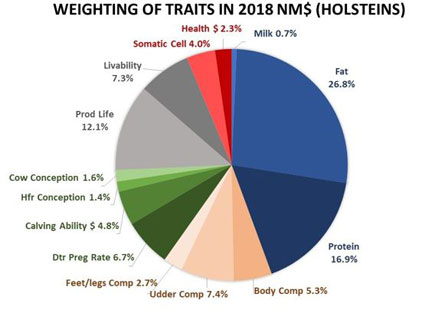
With the August U.S. dairy genetic evaluations, Net Merit $ and the other lifetime profit indices have been revised to factor in disease resistance and to update the economic values used in calculations. Net Merit (NM$), Cheese Merit (CM$), Fluid Merit (FM$) and Grazing Merit (GM$) were revised for the triannual genetic evaluations released August 7 by the Council on Dairy Cattle Breeding (CDCB).
“It is exciting to incorporate these direct measures of disease resistance, so that Net Merit continues to evolve and provide the most relevant information for dairy producers as they work to breed and manage healthy, productive herds,” said João Dürr, CDCB chief executive officer.
In April 2018, evaluations for genetic resistance to six health disorders were launched by CDCB. For Holstein males and females, genetic and genomic evaluations then became available for six common and costly health events – Displaced Abomasum (DA), Hypocalcemia (MFEV), Ketosis (KETO), Mastitis (MAST), Metritis (METR) and Retained Placenta (RETP).
CDCB collaborates with the Animal Genomics and Improvement Laboratory (AGIL) to ensure that cutting-edge research is used to produce quality genetic evaluations. The research of AGIL, a division of the United States Department of Agriculture, was critical to establish appropriate economic values and weightings of the individual traits within the Net Merit index.
"Dairy producers can select for any combination of traits, but total genetic progress will be fastest using an index,” said Dr. Paul VanRaden, Research Geneticist at USDA AGIL. “Because many traits affect profitability, total profit usually increases when more traits are included in the selection index if the evaluations are accurate and correct economic values are used.”

Emphasis of Health Traits in Net Merit
The six disease resistance traits were incorporated in NM$ through the new sub-index, Health Trait $ (HTH$), at a relative value of 2.3% for NM$, 1.9% for Cheese Merit (CM$), 2.3% for Fluid Merit (FM$) and 2.1% for Grazing Merit (GM$). The new Health Trait $ sub-index is not published separately, similar to the calving trait sub-index (CA$).
Relative emphasis on most other traits reduced slightly due to the addition of HTH$; however, yield trait emphasis increased slightly and somatic cell score (SCS) emphasis decreased greatly because of correlated health costs now assigned directly to HTH$.
“The actual benefits from adding health traits may not appear as large as some expect – because other traits such as productive life, SCS, fertility, livability and calving ease also directly or indirectly account for impacts on animal health,” stated VanRaden.
Additional Evaluation Changes
A handful of other changes were implemented by CDCB for the August evaluations, as part of the mission to apply current research and drive continuous improvement. These changes are described on the CDCB website. Most significantly, the model for female fertility traits was changed to address unexpected variability and heterosis procedures were updated to utilize exact Expected Future Inbreeding (EFI) as possible.
Access to Genetic Evaluations
The CDCB website includes a wealth of dairy genetic summaries, tables and lists, in addition to publicly-available queries on individual animals. The site is updated with lists for all sires, elite cows and heifers for Net Merit, and high-ranking grade cows and heifers, as well as comparative summaries. Further information will be available August 9 at 1 p.m. (EDT) to reflect the status of semen availability for sires in AI (artificial insemination). Additionally, the official CDCB evaluations will be published in various formats by breed associations, artificial insemination and genetic suppliers, dairy herd information (DHI), dairy magazines and other industry sources.
The next triannual evaluation will be December 4, 2018, and the 2019 release dates are April 2, August 13 and December 3. These triannual releases provide the genetic evaluations for individual animals used by dairy producers, genetic suppliers, breed associations and other dairy stakeholders.
About Council on Dairy Cattle Breeding (CDCB)
The Council on Dairy Cattle Breeding (CDCB), in Bowie, Md., provides premier dairy genetic information services through industry collaboration centered around a mission to help optimize cow health and productivity in herds worldwide. The CDCB drives continuous improvement and maintains the integrity of the world’s largest animal database, building on a quality foundation with more than eight decades of recorded U.S. dairy animal performance. The CDCB is a collaborative effort between four sectors of the U.S. dairy industry: Dairy Records Providers (DRP), Dairy Records Processing Centers (DRPC), National Association of Animal Breeders (NAAB) and Purebred Dairy Cattle Association (PDCA).


